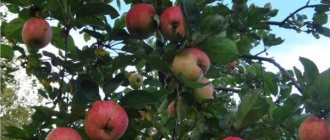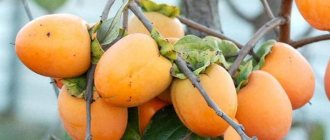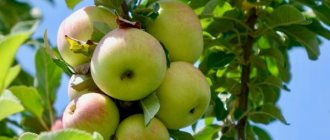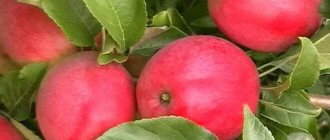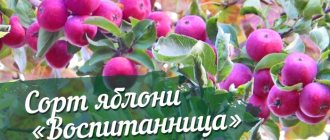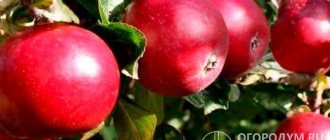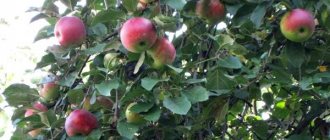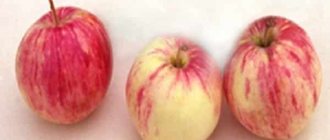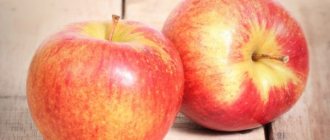Choosing the right apple tree variety is an important task for a gardener. The variety of varieties often discourages summer residents. After all, landing space is limited.
An unfamiliar variety may not satisfy the gardener’s wishes, and this will only be known after a few years, when the tree begins to bear fruit.
Therefore, it is better to plant proven varieties , the declared characteristics of which have been confirmed by time and feedback from the owners.
In this article we will look at the Medunitsa apple tree variety: description, photos, reviews, planting and much more. Attention! Lungwort is recognized by gardeners as one of the best summer sweet apple trees of early ripening.
Reviews
Galina Ivanovna (Stavropol): “You should enjoy the apples of Lungwort straight from the tree. This is how you feel the spicy aroma and sweet honey taste most of all.”
Arkady (Perm): “The tree is already more than seven years old, but it produces a large harvest every year. We eat apples from the branch; there is more than enough for winter supplies. Lungwort makes very fragrant jams and preserves.”
Svetlana (Ekaterinburg): “The whole family liked the variety. It so happens that we don’t like sour apples. Lungwort has an exceptionally sweet taste, without a hint of acid. At the same time, the apples are dense and very juicy.”
Petr Sergeevich (Tomsk): “I appreciate the winter Lungwort because the apples do not fall off, have time to fully ripen on the tree and are well stored. The only “but” is that the honey taste disappears over time.”
This abundantly fruiting summer variety is perfect for those who prefer sweet apples. Reading reviews about it, the Lungwort apple tree just begs to be purchased.
Winter apple variety
For more than half a century, thanks to the work of breeders, many variations based on Lungwort have been created. The purpose of breeding work was to improve the frost resistance of trees and increase the shelf life of fruits. The result of many years of research was the winter lungwort apple tree.
Description of winter lungwort, photos, reviews:
- Apples ripen a month later - at the end of September;
- The fruits are stored until spring;
- In the winter version of Lungwort, the acid content in the fruits is much higher than in the summer version. Therefore, winter apples are not so sweet during the ripening period;
- The rules for planting and subsequent care of winter lungwort are practically no different from the recommendations for caring for the summer variety.
When planting a winter apple tree, you should take into account the flowering time and plant good pollinators nearby. The flowering period of both should coincide.
Interesting! Regular consumption of apples minimizes the risk of cardiovascular diseases.
The author of the video will tell you about the features of the Lungwort apple tree and its fruits
Selection
Selection work on the Medunitsa variety began back in the 30s of the last century. At its origins stood Professor S.I. Isaev, a well-known biologist in the Soviet years.
Thanks to his work, more than 40 varieties of winter-hardy, disease-resistant apple trees . Growing immune varieties was the main activity of the breeder. The Lungwort was created by crossing a Welsey and a Cinnamon Stripe.
The Lungwort is a cross between a Welsey and a Cinnamon Stripe.
Contrary to popular belief, the apple tree did not get its name for its honey taste. This is a reference to the widespread flower that is one of the first to appear in the spring.
The professor called his wife “Lungwort,” and later gave this name to the legendary apple tree. This variety is also sometimes called “Medovitsa” (the apple tree, by the way, in the mid-50s served as the basis for the biologist being awarded the Stalin Prize).
Important! The variety is still not included in the State Register. This does not prevent him from being loved by many gardeners in the country.
Apple tree Lungwort. Description
The description and main characteristics of the Medunitsa variety will allow you to recognize it by the distinctive features of the structure of the tree and its fruits and understand what qualities are behind its popularity and what disadvantages it has. Below you will find a photo and description of the variety.
Appearance
Lungwort belongs to the tall varieties . On a seed rootstock, the tree can grow up to 5-7 meters . The skeleton of the crown under natural conditions is sparse and has a pyramidal shape .
The tree is quite wide and well leafy. The variety is characterized by an average ability for shoot formation . The combination of this indicator and high growth requires special pruning for the correct development of the tree and simultaneous ripening of the fruit.
Apple tree variety Medunitsa.
Foliage
The main shade of the crown is light green . The shoots are light brown. themselves are round, oblong, and often have a slight yellow tint. The curvature of the leaf plates is weakly expressed.
Fetus
Summer lungwort apple tree . Its fruits are of medium size . An apple rarely weighs more than 150 g. The shape is round and regular. Conical specimens may also be found on the tree.
Apples at technical ripeness are yellow-green, with pronounced orange-red stripes . When fully ripe, the fruit may be completely red , or may have a large blush on an overall yellow background. The stripes remain visible.
To taste, Lungwort belongs to the sweet varieties . The sugar content in fruits is greater than or equal to 14%. Acidity is reduced .
Tasting score at full maturity - 4.2 - 4.6 points out of 5.
The pulp is dense and juicy . Apples have a pronounced aroma and taste with a slight honey tint.
The uniqueness of the taste lies in the fact that Lungwort is capable of growing in cold climate zones . A characteristic feature of apple trees, traditional for the middle zone, is high acidity. This summer variety is considered one of the best, as it has a pure sweet taste unique to apple trees in central and northern latitudes.
See the video below to see what the fruits of Lungwort look like:
Harvest and storage
Apples growing on different sides of the tree are exposed to different amounts of sunlight and ripen unevenly. But even after reaching the maturity stage, the fruits remain hanging on the tree and do not fall off.
Summer and winter lungwort are characterized by different harvest times, and their fruits have different shelf life:
- ripe summer Lungwort apples are harvested from late August to late September;
- the fruits of the winter variety Lungwort ripen from mid-September to the end of October;
- fruits are picked from the tree by hand in 2-3 approaches, as they reach maturity;
- Only apples with whole peels without mechanical damage or rotten areas are stored;
- when stored in a dark, cool basement, the fruits of the summer variety remain fresh for 1 month;
- the initial sweet taste and light aroma of apples are preserved only for 2 weeks from the date of harvest;
- The shelf life of winter lungwort fruits at an air temperature of +3...+5°C is up to 3-4 months.
Important! To increase the shelf life of fresh apples, you can wrap each of them in a layer of paper and place them in layers in prepared boxes.
Even a novice gardener can grow a Medunitsa apple tree on his own plot. To do this, it is enough to follow the recommendations for cultivation and care listed in this article, and a generous harvest of sweet and juicy fruits will not take long to arrive.
Characteristic
Fruiting
On the seed rootstock, Lungwort begins to produce crops in 5-6 years . Moreover, the tree can actively bear fruit for more than 50 years. The apple tree is famous for its annual fruiting only for the first 12-15 years . After this, rationing of the ovaries is necessary if it is necessary to obtain a harvest every year.
The main harvest occurs in the middle zone in mid-August - early September . Under natural conditions, fruits ripen unevenly. This is due to the strong foliage of the shoots, due to which some of the fruits lack light.
Attention! One of the advantages of the variety is that the fruits practically do not fall off and can hang on the branches for a long time when ripe.
Flowering and pollinator varieties
Lungwort is a self-fertile variety companions for it . The variety should be selected according to the flowering period . In this case, the ripening period of apples may not coincide.
The flowering period of Lungwort falls on the end of May - mid-June , depending on the climatic zone of growth.
Good pollinators of the Lungwort apple tree:
- Cinnamon Striped;
- Victory;
- Anise Sverdlovsk.
Chinese ones, for example, Golden or Kerr, are also suitable.
Cinnamon striped.
Victory.
Anise Sverdlovsk.
Harvest storage
The harvest can be harvested in a state of technical ripeness and fully ripened . In the first case, under optimal conditions, apples can be stored for up to 3-4 months. In the second - no more than a month.
You should remember about the peculiarity of Lungwort fruits that change their taste over time . The most pronounced aroma and rich honey taste usually last no longer than two weeks after harvest.
Winter hardiness
Frost resistance of Lungwort is one of the main indicators for which this variety is valued. The tree rarely suffers from severe winter frosts or repeated spring frosts.
The variety is successfully cultivated in the conditions of the Urals and Siberia, without changing the declared characteristics.
Resistance to major diseases
In those years when the variety was bred, there was an increased incidence of scab in apple orchards. When breeding Lungwort, the breeders faced the main task - to create a tree that would be resistant specifically to this fungal infection. The goal was achieved.
Therefore , it is believed that Lungwort is not susceptible to scab. The same information is rewritten by all known sources that contain a description of this variety.
However, this is not entirely true. Over the years, new strains of the disease , to which the old varieties lack stable immunity. Therefore, preventive treatments for this variety are necessary.
Scab prevention is mandatory for Lungwort!
The disadvantages of the variety include:
- The need for pruning to limit growth and proper fruiting;
- In adulthood, the need for annual crop rationing;
- Short storage period;
- Lack of simultaneous ripening of fruits;
- Loss of characteristic taste during storage.
Important! Almost any deficiency of the Medunitsa variety can be corrected with proper tree care.
The quality characteristics of a variety and its external data can be significantly changed if you choose a seedling on a clonal rootstock.
Advantages and disadvantages
Having absorbed the best parental qualities, the Medunitsa variety received many advantages.
Advantages of the variety:
- high winter hardiness;
- excellent resistance to fruit rot and scab;
- stable and large harvest;
- early maturation;
- rich honey taste and pleasant aroma of apples;
- low sugar content;
- Quite a long shelf life for a summer variety.
Disadvantages of the variety:
- uneven ripening of fruits;
- impressive size of the tree;
- difficulty in harvesting without crown formation.
Types of rootstocks and variety variations
When purchasing a plant, it is the rootstock that should be given significant attention . It will largely depend on:
- The height of the apple tree, its appearance and size;
- Dates of fruiting and ripening;
- Tree planting scheme;
- Duration of fruiting and lifespan of an apple tree.
Seminal
Lungwort on a seed rootstock is capable of bearing fruit annually for 50-60 years. The lifespan of the tree can reach 80-90 years. Of course, this will require good care and regular regulatory pruning.
Main characteristics of Lungwort on seed rootstock:
- The height of an adult tree is 5-7 meters;
- The period of fruiting is 5–6 years;
- The minimum landing interval is 4.5 m.
The wide crowns of a tall apple tree should not touch, so it is better if a distance of 5-6 meters is maintained between them .
Semi-dwarf
Experts recommend purchasing tall varieties on semi-dwarf rootstocks. The Medunitsa apple tree variety on a semi-dwarf rootstock is convenient for regular care and harvesting . Unlike natural growth, the height of the seedling will be much lower, and fruiting will begin earlier.
Main characteristics of Lungwort on a semi-dwarf rootstock:
- The height of the apple tree is 4 - 4.5 meters;
- Fruiting occurs in 3.5 – 4.5 years;
- The minimum landing interval is 3 m.
Comfortable planting scheme for Lungwort 4 x 3 m.
Lungworts on a semi-dwarf rootstock.
Important! The peculiarity of the semi-dwarf Lungwort is that it is able to grow when the groundwater is quite close. This is due to the fact that the variety itself is quite tolerant of short-term waterlogging. The rootstock enhances this quality.
Dwarf and columnar
The fashion for miniature apple trees appeared relatively recently. Small trees are convenient and decorative. Despite the fact that the natural shape of Lungwort is pyramidal, a low-growing apple tree can become the owner of a spherical or triangular crown. The gradual formation of the crown will not harm fruiting.
Main characteristics of Lungwort on a dwarf rootstock:
- The height of the lungwort apple tree on a dwarf rootstock is 1.5 - 2 meters;
- The period of fruiting is 2.5–3 years;
- The minimum landing interval is 1 m.
Lungwort fruits on a dwarf rootstock.
Advice! When planting dwarf apple trees in intensive gardens, closer planting is possible.
The peculiarity of dwarf rootstocks is that fruiting can occur much earlier . Sometimes the first fruits can begin to ripen already in the year of planting a two-year-old seedling. For the development of the tree, it is better not to let the apple tree bear fruit at such an early age and to tear off the ovaries.
The apple tree variety Lungwort on a dwarf rootstock requires a special approach in order to achieve good fruiting and sustainable development. Trees require garter , since the root system of dwarfs is not too deep. Large wind loads can tear an apple tree out of the ground.
In addition, miniature trees are designed for intensive fruiting, so they do not live long . The average fruiting period for dwarfs is 12 years.
As for the columnar forms, there are more suitable varieties for them than the columnar Lungwort.
The description of such famous apple trees as Currency, Yesenia, and the Moscow Necklace contains information about their natural shape, which initially looks like a column. The gardener can only support it.
Grafting Lungwort onto a columnar rootstock is possible , but the end result will be a pyramidal dwarf tree . Therefore, this form of Lungwort is rarely found on sale.
Winter option
The summer variety was so in demand due to its characteristics that variations of the Medunitsa variety arose. The most widespread was the winter lungwort apple . Its fruits ripen much later, by the end of September , but can also be stored until spring.
Winter lungwort.
Attention! Despite the same name, winter lungwort contains more acids and does not have as sweet a taste as summer lungwort.
Protection from diseases and pests
Despite the fact that Lungwort is resistant to fungal diseases and many pests, in unfavorable conditions it can still get sick. To prevent danger, it is important to carry out preventive measures in a timely manner.
In early spring, before the buds open, it is recommended to treat the apple tree with a solution of copper sulfate (100 g per 10 liters of water). Also, for the purpose of prevention and pest control, spraying with a decoction of the leaves or flowers of herbaceous, black or red elderberry is useful. 1 kg of raw material is poured into 10 liters of water and left for 24 hours. Add 50 g of laundry soap to the freshly prepared solution.
Timely spraying is the key to apple tree health
To protect against scab and fruit rot, the trunk circle is treated once before flowering with a 10% solution of ammonium nitrate, and the tree is treated with a 2% solution of Bordeaux mixture.
In the fall after fruiting and in the spring before the buds open, it is necessary to whiten the tree trunk.
Whitewashing the trunk will help protect the apple tree from various diseases and small insect pests.
To protect against rodents in winter, the apple tree should be covered with spruce branches or wrapped with roofing material or roofing felt. Nylon tights, matting and burlap are also suitable.
Landing
Planting and caring for the Lungwort variety is not much different from planting any summer apple tree. The rules for planting a young tree consist of determining the timing and proper preparation of the site.
Deadlines
Depending on the area where planting will take place, early spring or late autumn is chosen for this type of work.
So in the middle zone , for example, in the Moscow region or Leningrad region, autumn planting .
And in the conditions of Siberia and the Urals , the best time to plant apple trees of the Medunitsa variety is in the spring . This will allow you to avoid damage from the possible onset of cold weather: in the middle zone - spring frosts, and in the north - early autumn frosts.
If the region receives little snow , fruit trees should also be planted in the spring.
The peculiarities of planting the Medunitsa apple tree in the early spring are to carry out work only at positive temperatures.
By this time, the soil should have thawed and can be easily worked at a depth of 50 - 60 cm.
Before you properly plant the Lungwort apple tree in the fall, you should remember that:
- There should be at least three weeks left before the onset of cold weather;
- Lungwort should not be planted too early; prolonged heat will provoke active growth of shoots that will die during the first autumn frosts.
Process
Preparation of the landing site and the process itself consists of several stages. The first stage begins six months before the expected landing. If the apple tree is planted in the spring, then the place is prepared in the fall. If planting is planned for the fall, it is better to prepare the planting hole in the spring or during the summer.
Technology:
- Having decided on the planting site, you should dig a hole, the size of which will be slightly larger than the root ball of the seedling (for a two-year-old it is approximately 50x50x50cm);
- The excavated soil should be divided into the fertile part and the remaining soil;
- Mix the fertile part with fertilizers, fill the hole halfway with the mixture;
- A stake is driven in the center, to which the seedling will later be tied;
- The young tree should be placed in the center, its roots spread out and covered with earthen mixture to the edges of the hole;
- The seedling should be carefully watered and the soil compacted.
Landing technology.
Do not actively press down the soil around the roots, as this can damage them. It’s better to water the planting well, add more soil and water it again.
Care
Features of caring for an apple tree include pruning, feeding and protection.
The first year after planting, the tree does not need special care. It is better to postpone all procedures until next season. The only thing you need to pay attention to is watering.
The first month is carried out as the top layer of soil dries completely. In the future, it will be enough to water the young Lungwort once a week.
Already next year you can start pruning.
The formation of the crown of the Lungwort apple tree begins at the age of two years. Most often, an apple tree is formed in the form of sparse tiers with a distance of 30-40 cm between them . This method maintains the natural pyramidal shape of the plant.
It is possible to form Lungwort in the shape of a bowl , in which the central shoot is cut out of the tree, replacing it with 4 - 5 side branches.
The variety is fast-growing and vigorous, while its shoot formation is weak. These indicators create immutable rules for pruning a young tree:
- Every spring and autumn, Lungwort needs sanitary pruning, during which all damaged and diseased branches are removed;
- The variety requires annual spring pruning, which thins out the crown and stimulates the formation of new shoots;
- In summer, it is recommended to pinch out young growths and remove branches that shade most of the fruit.
Advice! If there is a need to harvest from an adult lungwort every year, it is necessary to normalize the number of ovaries every spring.
Fertilizing should be carried out in spring and autumn . Spring work should stimulate the collection of green mass, growth and formation of the crop. The tree will need nitrogen.
The main direction of fertilizing in the fall is ripening of wood and preparation for wintering. During this period, it is better to support the apple tree with phosphorus and potassium . It is extremely important to follow the dosage when using fertilizers.
Care at the end of the season is also important . All plant debris should be removed from the tree trunk circle, the soil should be dug shallowly and the trunk should be protected from frost.
In young trees, it is better not to whiten the trunk, but to wrap it with spruce branches. Mature trees are whitened twice a year - in spring and autumn.
Lungwort needs prevention from major infections and pests. To do this, trees are sprayed with copper-containing preparations in early spring.
Good care will allow the apple tree to successfully grow and bear fruit for several decades. The variety has already passed the test of time and is appreciated by gardeners. If there is no Lungwort in the orchard yet, this is a reason to think about purchasing this wonderful variety.
Pollinator trees
The Lungwort apple tree is a self-fertile variety, however, experienced gardeners recommend planting pollinator trees with the same flowering period nearby in order to increase the yield of this fruit tree.
Related article:
Apple tree diseases and pests
The best pollinators in this case are:
- Anis Sverdlovsky;
- Kerr;
- White filling;
- Brown tabby;
- Chernenko's victory.
Answers to readers' questions
Readers most often have questions related to the fruiting of Lungwort. We will try to answer them.
How much do seedlings cost?
The price of seedlings depends on the rootstock, the age of the apple tree, the integrity of the root system, the region and the seller’s brand. For example, at the beginning of 2021, in the nursery of Vladimir you can find seedlings on a rootstock 54-118 cm from 400 to 700 rubles per piece (container 3-10 liters), and 25,000 rubles per seedling in a container 65-110 liters.
The most expensive will be a columnar or dwarf seedling over three years old, grown in a container. The apple tree is already bearing fruit and the buyer immediately sees that he has the right variety in front of him. You can transplant the plant into the garden without damaging the root system.
is much cheaper to purchase a seedling on a seed rootstock with an open root system. In this case, you will have to wait 5-6 years to get the first harvest and ensure varietal compliance. The height of the tree over the years of development can increase to 7-8 meters.
What year does it begin to bear fruit?
The beginning of fruiting of Lungwort can be determined by the rootstock. The smaller it is, the shorter the waiting period for the harvest. The average age at which Lungwort begins to bear fruit is 5 years.
Why doesn't it bear fruit?
If the apple tree not only does not bear fruit, but also does not bloom, perhaps it has not yet reached the age of fruiting or the buds have been damaged by return frosts;
If the apple tree blooms, but the fruits do not set, this may be due to poor pollination of the tree or to pests that destroy the flowers.
Fruits of Lungwort.
How to care during flowering?
During flowering, Lungwort should create good conditions for pollination . This will increase the yield of young trees. bee-attracting compositions based on honey and sugar are hung on trees . You can place containers with water in the crown of Lungwort and put flowering branches of another summer variety in them.
Features of ripening and fruiting
According to the description of the variety, the beginning of fruiting of Lungwort depends on the rootstock: on a seed rootstock it is 5-6 years after planting the apple tree, on a semi-dwarf rootstock - 3-4 years, on a dwarf rootstock - 2-3 years.
The greatest productivity is at the age of 8-12 years. After this, the dwarf varieties sharply lose their ability to produce crops. Tall types can bear fruit for up to 50-70 years.
Summer Lungwort begins to ripen in mid-August, and winter Lungwort begins to ripen in late September or early October. The apples take on a yellow-green hue, then red stripes appear on their surface. Over time, they become less clear and blurry. If the fruit is facing the sun, it may turn completely red. In a shaded area, even ripe apples remain yellow and slightly striped.
One of the features of ripening is unevenness. Some fruits are ready for consumption already in the first ten days of August, others only at the beginning of September. This is due to the high dependence of the ripening of the variety on lighting and sunlight.
If apples grow in the shade, covered with leaves, they take longer to reach condition.
